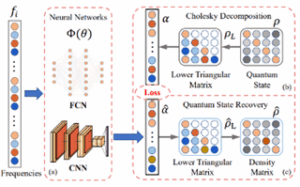24.07.2025Open Position MEP/BEP
Open position MEP: Memristors-based Neural Networks hardware accelerator for Quantum state tomography
Ryoichi Ishihara
Associate Professor, Group leader
Qutech, Dep. Quantum and Computer Engineering, Faculty of Electrical Engineering, Mathematics and Computer Science, Delft University of Technology
Ishihara-lab focuses on the integration technologies for unconventional electronic systems; quantum computers, quantum sensors, neuromorphic computers, and biodegradable sensors. Our work involves new materials, scalable fabrication of electronic and photonic devices, and 3D heterogeneous integration, aiming to realize unconventional electronic systems.
Memristors-based Neural Networks hardware accelerator for Quantum state tomography
Neural Networks (NNs) have revolutionized various fields, including machine learning, data analysis, and pattern recognition. These networks are designed to mimic the human brain’s structure and its ability to learn from data. Quantum state tomography, on the other hand, is the process of reconstructing the quantum state of a system through measurements. Both areas have garnered significant attention due to their potential applications in quantum computing and information processing [1] .
In recent years, the development of novel computing architectures, such as memristor-based crossbars, has presented exciting opportunities for enhancing the training and performance of ANNs. Memristors are non-volatile memory devices with the ability to change resistance based on the history of applied voltage or current. Crossbars, which consist of an array of memristors arranged in a grid-like fashion, offer a massively parallel and dense architecture for computing [2] .
The utilization of memristor crossbars for training ANNs in the context of quantum state tomography holds tremendous promise. By leveraging the unique properties of memristors, such as low energy consumption, high density, and non-volatility, we aim to improve the efficiency and accuracy of quantum state tomography through ANNs. This innovative approach has the potential to overcome the computational challenges associated with the complex nature of quantum systems and pave the way for practical quantum information processing tasks.

Schematic of the ML-based QST approach. (a) A multi-layer neural network Φ(θ) maps the frequencies fi to the vector αˆ ; (b) Compute the Cholesky decomposition of the density matrices ρ as the ground-truth vector α for supervised training with a loss function; (c) Obtain the quantum state ρˆ from the network’s output αˆ [3].
- G. Torlai, et al., “Neural-network quantum state tomography,” Nat Phys, vol. 14, no. 5, 2018, pp. 447-+; DOI 10.1038/s41567-018-0048-5.
- S.I. Yi, et al., “Activity-difference training of deep neural networks using memristor crossbars,” Nat Electron, vol. 6, no. 1, 2023, pp. 45-51; DOI 10.1038/s41928-022-00869-w.
- Ma, Hailan, et al. Tomography of quantum states from structured measurements via quantum-aware transformer. No. arXiv: 2305.05433. 2023
Interested? Please contact Ryoichi Ishihara r.ishihara@tudelft.nl or Erbing Hua <E.Hua@tudelft.nl>